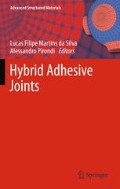Abstract
The idea of “hybrid joints” arises from the need of joining together materials, producing a tough, stiff and lightweight joint. The core concept is: use two different joining techniques, with the aim to increase the strength and gather the advantages of each technique, reducing the drawbacks. This chapter is devoted to clinch–adhesive (also called clinchbonded) joints, which is of particular interest for the chassis manufacturing in vehicles (automotive, trucks, buses, railways) but also of the nautical and ropeways applications. First, an overview of clinching, adhesive bonding and clinch–adhesive joint characteristics is given. The experimental details and the design of experiments plan are then described and the result are shown and discussed comparing the performances in terms of stiffness, strength and energy absorption to failure of simple and hybrid joints. Since one of the most important needs of the industry is the possibility to simulate mechanical behavior of the joint up to failure, damage models have been applied to the finite element analysis of the simple and hybrid joints and the results are shown in the last paragraph.
Access this chapter
Tax calculation will be finalised at checkout
Purchases are for personal use only
References
Aravas, N.: On the Numerical integration of a class of pressure-dependent plasticity models. Int. J. Numer. Methods Eng. 24, 1395–1416 (1987)
Carboni, M., Beretta, S., Monno, M.: Fatigue behaviour of tensile-shear loaded clinched joints. Eng. Fract. Mech. 73, 178–190 (2006)
Chu, C., Needleman, A.: Void nucleation effects in biaxially stretched sheets. J. Eng. Mater. Tech. 102, 249–256 (1980)
de Paula, A.A., Aguilar, M.T.P., Pertence, A.E.M., Cetlin, P.R.: Finite element simulations of the clinch joining of metallic sheets. J. Mater. Process. Technol. 182, 352–357 (2007)
Del Gamba, L.: Studio teorico e sperimentale del comportamento di unioni ottenute per clinciatura con o senza incollaggio (Experimental and numerical study of the behaviour of clinched and clinchbonded joints). Graduation Thesis, University of Pisa, Pisa, Italy (2005)
Hamel, V., Roelandt, J.M., Gacel, J.N., Schmit, F.: Finite element modeling of clinch forming with automatic remeshing. Comput. Struct. 77, 185–200 (2000)
Li, S., Thouless, M.D., Waas, A.M., Schroeder, J.A., Zavattieri, P.D. Use of a cohesive-zone model to analyze the fracture of a fiber-reinforced polymer-matrix composite. Compos. Sci. Tech. 65, 281–293 (2005)
Li, S., Thouless, M.D., Waas, A.M., Schroeder, J.A., Zavattieri, P.D.: Mixed-mode cohesive-zone models for fracture of an adhesively-bonded polymer-matrix composite. Eng. Fract. Mech. 73, 64–78 (2006)
Krenk, S. (1992) Energy release rate of symmetric adhesive joints. Eng. Fract. Mech. 43, 549–559
Needleman, A.: A numerical study of necking in circular cylindrical bars. J. Mech. Phys. Solids 20, 111–127 (1972)
Needleman, A.: A continuum model for void nucleation by inclusion debonding. J. Appl. Mech. 54, 525–531 (1987)
Needleman, A., Tvergaard, V.: Analysis of the cup-cone fracture in a round tensile bar. Acta Metall. 32, 157–169 (1984)
Needleman, A., Tvergaard, V.: Material Strain-Rate Sensitivity in the Round Tensile Bar. Brown University Report, Division of Engineering, Providence, USA (1985)
Petrie, E.M.: Handbook of Adhesives and Sealants. McGraw-Hill, UK (2000)
Pirondi, A.: Influence of cohesive law shape and adhesive modelling on the failure prediction of T-peel joints. In: Proceedings of XVI European Congress of Fracture, Alexandroupolis, Greece (2006)
SIMULIA: ABAQUS® User’s Manual, Ver. 6.7 (2007)
Tvergaard, V.: Influence of voids on shear band instabilities under plane strain conditions. Int. J. Fract. 17, 389–407 (1981)
Tvergaard, V., Hutchinson, J.: The relation between crack growth resistance and fracture process parameters in elastic-plastic solids. J. Mech. Phys. Solids 40, 1377–1397 (1992)
Varis, J.: Ohutlevyjen Puristusliittäminen (Clinching of Sheet Metals). Federation of Finnish Metal, Engineering and Electrotechnical Industries, MET, Helsinki, Finland (1997)
Varis, J.: Kuumasinkityn lujan rakenneteräksen puristusliitt¨aminen (Clinching of zinc-coated high strength structural steel). Research Report No. 27, Lappeenranta University of Technology, Department of Mechanical Engineering, Lappeenranta, Finland (1998)
Varis J., Lepisto J.: A simple testing-based procedure and simulation of the clinching process using finite element analysis for establishing clinching parameters. Thin-Walled Struct. 41, 691–709 (2003)
Author information
Authors and Affiliations
Corresponding author
Editor information
Editors and Affiliations
Rights and permissions
Copyright information
© 2010 Springer-Verlag Berlin Heidelberg
About this chapter
Cite this chapter
Pirondi, A., Moroni, F. (2010). Science of Clinch–Adhesive Joints. In: da Silva, L., Pirondi, A., Öchsner, A. (eds) Hybrid Adhesive Joints. Advanced Structured Materials, vol 6. Springer, Berlin, Heidelberg. https://doi.org/10.1007/8611_2010_36
Download citation
DOI: https://doi.org/10.1007/8611_2010_36
Published:
Publisher Name: Springer, Berlin, Heidelberg
Print ISBN: 978-3-642-16622-8
Online ISBN: 978-3-642-16623-5
eBook Packages: Chemistry and Materials ScienceChemistry and Material Science (R0)

